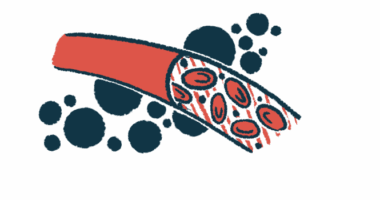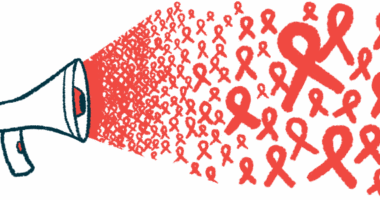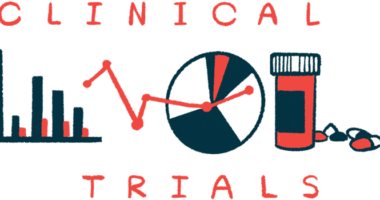Deconstructing DMD progression: A stage-by-stage care plan
Last updated Aug. 8, 2024, by Lindsey Shapiro, PhD

Treatment and care plans for Duchenne muscular dystrophy (DMD), a genetic disease where mutations in the DMD gene cause muscles to weaken and degenerate, should evolve over time to meet changing needs.
DMD is a progressive condition, meaning the symptoms of DMD worsen over time. People with the disease gradually lose their ability to walk, and increased weakness in the heart or respiratory muscles eventually lead to heart disease or breathing problems.
Because disease progression can vary significantly, each person’s DMD care plan will be different and address their specific needs and goals.
Disease progression in DMD
In general, the first DMD symptoms of muscle weakness are evident in early childhood. By adolescence, it likely progresses to wheelchair dependency, heart disease, and breathing difficulties.
DMD can be roughly categorized into five stages:
- diagnosis
- early ambulatory
- late ambulatory
- early nonambulatory
- late nonambulatory.
Still, DMD takes a different course in every person, even among siblings with the same disease-causing mutation. Doctors have various clinical tools used to track changes, so regular visits with an established care team is the best way to monitor each individual and determine their needs.
Stage 1: Diagnosis
DMD is usually diagnosed between the ages of 2 and 3 when the first signs of muscle weakness become evident. Muscle weakness usually first affects muscles closer to the core of the body — the proximal muscles — before extending to ones farther away. The legs are typically affected before the arms.
Parents may notice their child is slower to reach typical developmental milestones than their peers. For example, they start walking or talking later, although this will not always be the case. Children with DMD also may have more trouble doing certain movements, like climbing stairs or running, or appear clumsy and fall often.
Other early signs of DMD may include:
- enlarged calves
- Gower’s maneuver, where children get up from a seated position by walking their hands up their legs to compensate for weak hip and thigh muscles
- extreme elevations in creatine kinase levels, a marker of muscle damage
- learning disabilities/delays or speech delays.
These signs and symptoms may indicate the need for genetic testing to confirm a DMD diagnosis.
Stage 2: Early ambulatory
In the period after DMD is diagnosed, children may not have any symptoms or only have subtle symptoms of the disease. They are still usually completely ambulatory, meaning they are able to walk. There may even be a plateau phase because DMD symptoms are not progressing.
Still, during this stage, children with DMD may have a harder time with physical tasks such as climbing stairs or running due to slowly weakening thigh muscles. Or, they may complain of achy leg muscles. They might also use various compensatory behaviors to adjust, such as walking on their toes or the balls of their feet, or walking with their bellies out and shoulders pulled back.
Stage 3: Late ambulatory
As children with DMD become adolescents, they will start to experience more fatigue and it will be harder for them to physically keep up with their peers.
At this point, while they can still walk, they may require a walking aid or wheelchair to help prevent fatigue for long distances.
Stage 4: Early nonambulatory
At some point, usually during adolescence, people with DMD become reliant on a wheelchair. It usually happens around the age of 12, though the age can vary substantially. Muscle weakness will now affect the upper limbs, and activities involving the arms might be more difficult to do.
Progressing weakness in the back muscles coupled with having to sit for most of the day means scoliosis, or an abnormal curvature of the spine, may begin to develop and further limit a person’s physical abilities.
In the early teen years, people with DMD commonly start experiencing symptoms of cardiomyopathy, a disease of the heart’s muscle that makes it harder to pump blood. Breathing difficulties from respiratory muscle weakness might also become evident, but these issues don’t always start out as obvious shortness of breath. Signs of decreasing respiratory function might include headaches, difficulty concentrating, or nightmares.
Stage 5: Late nonambulatory
By adulthood, people with DMD will be wheelchair-bound and have increasing difficulty using their hands. Nearly all will have signs of cardiomyopathy, and for most, heart disease will have progressed significantly. As the diaphragm, the main breathing muscle, gets weaker, adults with DMD tend to have more difficulty taking deep breaths or coughing, and may have low oxygen levels at night.
DMD life expectancy is markedly reduced relative to healthy peers, mainly due to respiratory insufficiency or heart disease. But the disease prognosis has improved in recent years with new therapies and better care available, and some people with DMD reach their early 30s.
Care plan according to disease stage
The optimal care plan for DMD is continuously evolving as a person’s disease progresses. From the onset, DMD care requires a multidisciplinary team, ranging from primary care physicians to neuromuscular specialists, physical therapists, and nursing care, among others.
Families should be in frequent communication with their healthcare team to decide when changes in care are necessary or if new specialists need to be brought on board.
Diagnosis and early ambulatory stages
In the early stages of DMD, the most important care goals are to establish a stable healthcare team and start on interventions that can preventively slow the expected physical declines. Some of the most critical needs in these stages include the following:
- Establish a core care team, where primary care pediatricians and neuromuscular specialists are key components of DMD care. A pediatrician will keep track of parameters such as developmental milestones, general health, and vaccines, while the neuromuscular specialist will monitor how DMD is progressing and help decide on appropriate therapies.
- Children with DMD are usually put on steroids, which are anti-inflammatory medications that can help slow down muscle damage. It is best to begin these when children are still stable and before there are substantial motor declines. Families and doctors also may want to have discussions about any other possible treatments.
- Physical therapy is key for children with DMD, even if they don’t have symptoms yet. Safe and appropriate exercise regimens can help keep muscles strong and delay losing physical abilities.
- Because children are actively growing, it is important to speak with a registered dietitian or nutritionist early on to help make sure children with DMD are getting the right nutrients to stay strong. This is especially important if they’re taking medications such as steroids, which can affect a child’s weight and bone health.
Although breathing and heart problems usually aren’t an issue at this stage, a child’s doctors will likely want to start closely monitoring their cardiac and lung function. Children with developmental delays may also require learning, behavioral, or speech support throughout childhood.
Late ambulatory stage
Motor declines become most obvious in this stage. Children with DMD will continue using steroids and going to physical therapy to help slow those declines. During the late ambulatory stage, there are some new considerations for care that will need to be taken.
- Muscle and joint care is particularly important. It might include stretching several times a week to help delay or minimize contractures (where the joints become locked in one position). Braces and splints, or orthoses, might also help.
- Heart care is also important. Even though heart symptoms are not usually evident at this stage, tests might reveal early signs of heart disease that aren’t yet symptomatic. For this reason, children with DMD should be seeing a cardiologist at least every other year until age 10 and then yearly after that.
- Mobility aids might be required at this stage to help people with DMD get around independently and safely. Mobility aids include strollers, scooters, and wheelchairs.
- Mental health care should be considered. As children with DMD age, they start to become more aware of their condition and differences from their peers. This can cause emotional distress and require counseling from a trained mental health professional.
While lung function is usually not significantly affected yet, children with DMD should be getting lung function tests at least once a year. They also may need additional support at home or school if they have learning or behavioral issues.
Early nonambulatory stage
At this stage, DMD patients are often in adolescence, which is a challenging time even without having DMD. They will be dealing with normal adolescent changes, such as puberty, along with the physical declines from their disease. Mental health support will continue to be an important part of care, especially as teens navigate becoming more mentally and emotionally independent while simultaneously being more physically dependent on caregivers.
Although they may still seem young, many adolescents with DMD start the transition to adult care during this stage because the transition is a gradual, multi-year process. They also may want greater involvement in determining their healthcare plan.
Many aspects of care are similar to previous stages, although some areas might need to be further adapted.
- Mobility and accessibility needs to be reassessed, as people with DMD are wheelchair-dependent at this point. Adaptations might be needed at the home to get around more easily. This might include making changes such as adding ramps or widening doorways.
- Heart care is very important at this stage, as heart problems are common. Children should be started on cardiac medications at the first sign that the heart isn’t working properly, usually around age 10. Visits with a cardiologist should be yearly, but may become more frequent if there are signs of heart issues.
- Respiratory care plays a bigger role at this stage. Lung function should be routinely monitored by a pulmonologist once a child reaches age 12, becomes wheelchair-dependent, or has noticeable signs of reduced breathing capacity. If breathing issues are causing oxygen reductions during sleep, noninvasive ventilation at night might be required to aid breathing. Other types of care to assist with coughing might also be started.
- Orthopedic care must be considered, especially if adolescents develop significant contractures or serious scoliosis. Surgery may be required to address these issues and prevent further physical limitations. These kinds of surgeries are usually done during adolescence.
Late nonambulatory stage
From late adolescence into adulthood, DMD patients will finalize their transition to adult care by planning how they can maintain as much independence as possible. At this point, stretching is still an important part of care. Steroids might be reduced or stopped if their risks are outweighing the benefits.
Visits with cardiologists and pulmonologists to manage heart and lung issues continue but may become more frequent as DMD progresses and these issues become more invasive. Medications for heart disease will be started if they have not already begun.
Additional considerations for adults with DMD include:
- mobility and accessibility, as both upper and lower limb function are substantially affected at this stage, so more adaptive equipment may be necessary to help adults with DMD do daily life activities including eating, drinking, toileting, and transitioning in and out of a wheelchair. Families may consider at-home nursing care or other types of support at this stage to support caregivers with assistive functions.
- mental health, as the physical limitations of DMD and the knowledge that it can shorten life expectancy takes a significant toll. Feelings of frustration, anger, or sadness are common, and it is important for adults with DMD to have people to talk to, including mental healthcare professionals and trusted individuals in their lives.
The important role of caregivers
Caregivers play a critical role in DMD management at every stage, as they are primarily responsible for managing day-to-day life.
There will be new challenges to navigate along the way, ranging from medication management and keeping track of appointments to, in the advanced stages, offering significant physical support with daily life tasks such as toileting and eating. Caregivers also play an important role as advocates for their child with DMD when deciding on an appropriate care plan that offers the best possible quality of life.
Caregivers should always keep in mind maintaining their own physical and mental health is also a critical component of the DMD care plan. Practicing self-care ensures caregivers have the bandwidth to provide the best possible support to their loved one with DMD.
Muscular Dystrophy News Today is strictly a news and information website about the disease. It does not provide medical advice, diagnosis or treatment. This content is not intended to be a substitute for professional medical advice, diagnosis, or treatment. Always seek the advice of your physician or other qualified health provider with any questions you may have regarding a medical condition. Never disregard professional medical advice or delay in seeking it because of something you have read on this website.
Related articles






